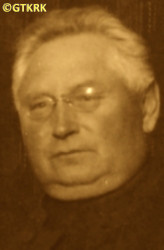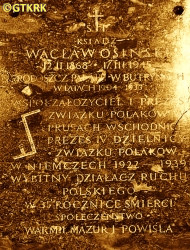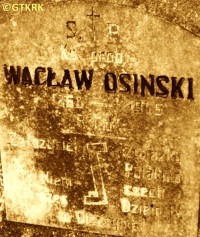Roman Catholic
St Sigismund parish
05-507 Słomczyn
85 Wiślana Str.
Konstancin deanery
Warsaw archdiocese, Poland
full list:
displayClick to display full list

searchClick to search full list by categories
wyświetlKliknij by wyświetlić pełną listę po polsku

szukajKliknij by przeszukać listę wg kategorii po polsku

Martyrology of the clergy — Poland
XX century (1914 – 1989)
personal data
surname
OSIŃSKI
forename(s)
Vaclav Xavier (pl. Wacław Ksawery)
function
diocesan priest
creed
Latin (Roman Catholic) Church RCmore on
en.wikipedia.org
[access: 2014.09.21]
diocese / province
Warmia diocesemore on
en.wikipedia.org
[access: 2018.09.02]
date and place
of death
17.03.1945

Wejherowotoday: Wejherowo gm., Wejherowo pov., Pomerania voiv., Poland
more on
en.wikipedia.org
[access: 2021.09.02]
details of death
After the end of World War I and rebirth of independent Poland Polish plebiscite activist in Warmia and Mazury — in 1919 deputy chairman of Peoples Council of Warmia and Polish population representative in Olsztyn county Council, among others.
After the plebiscite mandated by the League of Nations remained and ministered in his Butryny parish, on territories awarded to Germans — during preparations for the plebiscite, spoke at rallies and agitated for these lands to belong to Poland.
After national–socialist party NSDAP took power in Germany in 01.1933 attacked in 03.1933 by German thugs in his rectory in Butryny parish — for refusal to let NSDAP party representation with their banner onto cemetery grounds.
Forced to leave his parish and flee.
In 06.1933 retired.
As a Pole living in the–then Germany arrested by the Germans on 25.08.1939 — right before German and Russian invasion of Poland in 09.1939 and start of the World War II.
On c. 07.09.1939 jailed in KL Hohenbruch and next prob. in KL Sachsenhausen concentration camps.
In c. 10.1939 released.
Arrested again by the Germans in 12.1939.
In 02.1940 tried in Olsztyn — for helping Polish POWs — sentenced to 9 months in prison.
Held in Olsztyn prison (part of the time in prison hospital).
After release retired in Krosno n. Orneta and next in Orneta.
In the autumn of 1944, prior to Russian winter offensive of 1945 ending the World War II, evacuated to Pillawa, on both sides of the Strait of Pillawa of the Vistula Spit, separating the Vistula Lagoon from the Baltic Sea.
During German panic evacuation from advancing Germans managed to get to Wejherewo.
There, few days after Russian capture on 12.03.1945 of Wejherowo, perished.
cause of death
exhaustion
perpetrators
Germans
sites and events
KL SachsenhausenClick to display the description, KL HohenbruchClick to display the description, «Intelligenzaktion»Click to display the description, Ribbentrop‐MolotovClick to display the description, Pius XI's encyclicalsClick to display the description
date and place
of birth
12.02.1868

Sztumskie Poletoday: Sztum gm., Sztum pov., Pomerania voiv., Poland
more on
en.wikipedia.org
[access: 2022.01.28]
alt. dates and places
of birth
Sztumska Wieśtoday: Sztum gm., Sztum pov., Pomerania voiv., Poland
more on
en.wikipedia.org
[access: 2022.01.28]
presbyter (holy orders)
ordination
29.10.1894

Fromborktoday: Frombork gm., Braniewo pov., Warmia‐Masuria voiv., Poland
more on
en.wikipedia.org
[access: 2022.01.28]
positions held
resident — Ornetatoday: Orneta gm., Lidzbark Warmiński pov., Warmia‐Masuria voiv., Poland
more on
en.wikipedia.org
[access: 2022.01.28] ⋄ House of Retired Priests ⋄ St John the Baptist RC parish ⋄ Ornetatoday: Orneta gm., Lidzbark Warmiński pov., Warmia‐Masuria voiv., Poland
more on
en.wikipedia.org
[access: 2022.01.28] RC deanery
from c. 1941
resident — Krosnotoday: Orneta gm., Lidzbark Warmiński pov., Warmia‐Masuria voiv., Poland
more on
en.wikipedia.org
[access: 2020.11.01] ⋄ House of Retired Priests ⋄ Visitation of the Blessed Virgin Mary RC parish ⋄ Gdańsk (Free City of Danzig) RC diocese
from 1935
pensioner — Olsztyntoday: Olsztyn city pov., Warmia‐Masuria voiv., Poland
more on
en.wikipedia.org
[access: 2022.01.28]
1935 – 1939
chaplain — (Warmia and Powiśle i.e. by Vistula river regions)then part of German East Prussia
today: Poland ⋄ Polish scouting
1904 – 1933
parish priest — Butrynytoday: Pudra gm., Olsztyn pov., Warmia‐Masuria voiv., Poland
more on
en.wikipedia.org
[access: 2022.02.14] ⋄ St James RC parish ⋄ Olsztyntoday: Olsztyn city pov., Warmia‐Masuria voiv., Poland
more on
en.wikipedia.org
[access: 2022.01.28] RC deanery — also: from 1920, editor of the „Friend of the People” magazine, an organ of the Union of People's Societies; in 03.1911, founder of the Catholic Workers' Union
president — Olsztyntoday: Olsztyn city pov., Warmia‐Masuria voiv., Poland
more on
en.wikipedia.org
[access: 2022.01.28] ⋄ Polish–Catholic School Society
membership — Chief Council, Union of Poles in Germany ZPwN — also: co‐founder and from c. 1920 chairman of the 4th District of Union of Poles in Germany
from 1920
president — (East Prussia territory)Germ. Provinz Ostpreußen
today: part in Poland, part in Russia
more on
en.wikipedia.org
[access: 2022.09.11] ⋄ Union of Poles
1899 – 1904
vicar — Opaleniectoday: Chorzele gm., Przasnysz pov., Masovia voiv., Poland
more on
en.wikipedia.org
[access: 2022.08.05] ⋄ St Joseph RC parish ⋄ Mazurien Ideanery name
today: Warmia‐Masuria voiv., Poland RC deanery
1894 – 1899
vicar — Gietrzwałdtoday: Gietrzwałd gm., Olsztyn pov., Warmia‐Masuria voiv., Poland
more on
en.wikipedia.org
[access: 2022.01.28] ⋄ Nativity of the Blessed Virgin Mary RC parish ⋄ Olsztyntoday: Olsztyn city pov., Warmia‐Masuria voiv., Poland
more on
en.wikipedia.org
[access: 2022.01.28] RC deanery
1893 – 1905
editor — magazine, „Warmia Man”
1891 – 1894
student — Braniewotoday: Braniewo urban gm., Braniewo pov., Warmia‐Masuria voiv., Poland
more on
en.wikipedia.org
[access: 2022.02.14] ⋄ philosophy and theology, Theological Seminary
sites and events
descriptions
KL Sachsenhausen: In Germ. Konzentrationslager (Eng. concentration camp) KL Sachsenhausen, set up in the former Olympic village in 07.1936, hundreds of Polish priests were held in 1940, before being transported to KL Dachau. Some of them perished in KL Sachsenhausen. Murderous medical experiments on prisoners were carried out in the camp. In 1942‐1944 c. 140 prisoners slaved at manufacturing false British pounds, passports, visas, stamps and other documents. Other prisoners also had to do slave work, for Heinkel aircraft manufacturer, AEG and Siemens among others. On average c. 50,000 prisoners were held at any time. Altogether more than 200,000 inmates were in jailed in KL Sachsenhausen and its branched, out of which tens of thousands perished. Prior to Russian arrival mass evacuation was ordered by the Germans and c. 80,000 prisoners were marched west in so‐called „death marches” to other camps, i.e. KL Mauthausen‐Gusen and KL Bergen‐Belsen. The camp got liberated on 22.04.1945. After end of armed hostilities Germans set up there secret camp for German prisoners and „suspicious” Russian soldiers. (more on: en.wikipedia.orgClick to attempt to display webpage
[access: 2018.11.18])
KL Hohenbruch: German Germ. Konzentrationslager (Eng. concentration camp) KL Hohenbruch and forced labour camp, mainly for Poles — e.g. captured during «Intelligenzaktion» — in operation in 1939‐1944/1945 in East Prussia, n. Konigsberg. Prisoners — a few thousands — slaved mainly at forest clearances and swamp draining. C. 200 perished murdered. (more on: pl.wikipedia.orgClick to attempt to display webpage
[access: 2013.08.17])
«Intelligenzaktion»: German: «Intelligenzaktion» (English: „Intelligence Action”) — a German program of extermination of the Polish elite, mainly the intelligentsia and leadership layers, carried out from the beginning of the occupation in w 09.1939 to 04.1940, mainly in territories directly annexed to Germany, but also in the so‐called Germ. Generalgouvernement (Eng. General Governorate), where it was called «AB‐aktion». In the first phase, immediately after the beginning of the German occupation, during military operations carried out by the Germ. Wehrmacht (Eng. Armed Forces) and the genocidal units of the Germ. Einsatzgruppen (Eng. Operational Groups) of the Germ. Sicherheitspolizei (Eng. Security Police), i.e. SiPo, and Germ. Sicherheitsdienst des Reichsführers SS (Eng. Security Service of the Reichsführer SS), i.e. SD, organized by the Germ. Reichssicherheitshauptamt (Eng. Reich Main Security Office), i.e. RSHA, which followed the troops, carried out under the Germ. Unternehmen „Tannenberg” (Eng. Operation „Tannenberg”) — based on the so‐called Germ. Sonderfahndungsliste (Eng. Special Wanted Lists), i.e. proscription lists of Poles considered particularly dangerous to the Third Reich, prepared by the Zentralstelle II/P (Polen) unit of the German RSHA. Later, implemented by the German civilian occupation authorities and the genocidal unit of the Germ. Volksdeutscher Selbstschutz (Eng. Ethnic Germans Self‐Defense), whose members were Germ. Volksdeutsche (Eng. Ethnic Germans), i.e. representatives of the German minority in Poland. According to various sources, these lists, at the beginning of 09.1939, could have contained the details of 61,000—88,000 „dangerous” Poles — although these figures cannot be confirmed. In total, during this genocide, c. 50,000 teachers, Catholic priests, representatives of the landed gentry, freelancers, social and political activists, and retired military personnel were systematically and methodically murdered. Another 50,000 were sent to concentration camps, where only a negligible percentage survived. (more on: en.wikipedia.orgClick to attempt to display webpage
[access: 2014.10.04])
Ribbentrop‐Molotov: Genocidal Russian‐German alliance pact between Russian leader Joseph Stalin and German leader Adolf Hitler signed on 23.08.1939 in Moscow by respective foreign ministers, Mr. Vyacheslav Molotov for Russia and Joachim von Ribbentrop for Germany. The pact sanctioned and was the direct cause of joint Russian and German invasion of Poland and the outbreak of the World War II in 09.1939. In a political sense, the pact was an attempt to restore the status quo ante before 1914, with one exception, namely the „commercial” exchange of the so‐called „Kingdom of Poland”, which in 1914 was part of the Russian Empire, fore Eastern Galicia (today's western Ukraine), in 1914 belonging to the Austro‐Hungarian Empire. Galicia, including Lviv, was to be taken over by the Russians, the „Kingdom of Poland” — under the name of the General Governorate — Germany. The resultant „war was one of the greatest calamities and dramas of humanity in history, for two atheistic and anti‐Christian ideologies — national and international socialism — rejected God and His fifth Decalogue commandment: Thou shall not kill!” (Abp Stanislav Gądecki, 01.09.2019). The decisions taken — backed up by the betrayal of the formal allies of Poland, France and Germany, which on 12.09.1939, at a joint conference in Abbeville, decided not to provide aid to attacked Poland and not to take military action against Germany (a clear breach of treaty obligations with Poland) — were on 28.09.1939 slightly altered and made more precise when a treaty on „German‐Russian boundaries and friendship” was agreed by the same murderous signatories. One of its findings was establishment of spheres of influence in Central and Eastern Europe and in consequence IV partition of Poland. In one of its secret annexes agreed, that: „the Signatories will not tolerate on its respective territories any Polish propaganda that affects the territory of the other Side. On their respective territories they will suppress all such propaganda and inform each other of the measures taken to accomplish it”. The agreements resulted in a series of meeting between two genocidal organization representing both sides — German Gestapo and Russian NKVD when coordination of efforts to exterminate Polish intelligentsia and Polish leading classes (in Germany called «Intelligenzaktion», in Russia took the form of Katyń massacres) where discussed. Resulted in deaths of hundreds of thousands of Polish intelligentsia, including thousands of priests presented here, and tens of millions of ordinary people,. The results of this Russian‐German pact lasted till 1989 and are still in evidence even today. (more on: en.wikipedia.orgClick to attempt to display webpage
[access: 2015.09.30])
Pius XI's encyclicals: Facing the creation of two totalitarian systems in Europe, which seemed to compete with each other, though there were more similarities than contradictions between them, Pope Pius XI issued in 03.1937 (within 5 days) two encyclicals. In the „Mit brennender Sorge” (Eng. „With Burning Concern”) published on 14.03.1938, condemned the national socialism prevailing in Germany. The Pope wrote: „Whoever, following the old Germanic‐pre‐Christian beliefs, puts various impersonal fate in the place of a personal God, denies the wisdom of God and Providence […], whoever exalts earthly values: race or nation, or state, or state system, representatives of state power or other fundamental values of human society, […] and makes them the highest standard of all values, including religious ones, and idolizes them, this one […] is far from true faith in God and from a worldview corresponding to such faith”. On 19.03.1937, published „Divini Redemptoris” (Eng. „Divine Redeemer”), in which criticized Russian communism, dialectical materialism and the class struggle theory. The Pope wrote: „Communism deprives man of freedom, and therefore the spiritual basis of all life norms. It deprives the human person of all his dignity and any moral support with which he could resist the onslaught of blind passions […] This is the new gospel that Bolshevik and godless communism preaches as a message of salvation and redemption of humanity”… Pius XI demanded that the established human law be subjected to the natural law of God , recommended the implementation of the ideal of a Christian state and society, and called on Catholics to resist. Two years later, National Socialist Germany and Communist Russia came together and started World War II. (more on: www.vatican.vaClick to attempt to display webpage
[access: 2023.05.28], www.vatican.vaClick to attempt to display webpage
[access: 2023.05.28])
sources
personal:
leksykonkultury.ceik.euClick to attempt to display webpage
[access: 2013.12.04], katolicy1844.republika.plClick to attempt to display webpage
[access: 2021.12.19]
original images:
audiovis.nac.gov.plClick to attempt to display webpage
[access: 2019.10.13], leksykonkultury.ceik.euClick to attempt to display webpage
[access: 2013.12.04], nieobecni.com.plClick to attempt to display webpage
[access: 2019.10.13]
LETTER to CUSTODIAN/ADMINISTRATOR
If you have an Email client on your communicator/computer — such as Mozilla Thunderbird, Windows Mail or Microsoft Outlook, described at WikipediaPatrz:
en.wikipedia.org, among others — try the link below, please:
LETTER to CUSTODIAN/ADMINISTRATORClick and try to call your own Email client
If however you do not run such a client or the above link is not active please send an email to the Custodian/Administrator using your account — in your customary email/correspondence engine — at the following address:

giving the following as the subject:
MARTYROLOGY: OSIŃSKI Vaclav Xavier
To return to the biography press below:
 Click to return to biography
Click to return to biography










